Natylie Baldwin's Blog, page 2
October 8, 2025
Glen Diesen Interviews Mike Benz on How NGOs and the CIA Hijacked Ukraine
A great discussion on how the CIA-NGO complex started and how it works.
YouTube link here.
October 7, 2025
Paul Robinson: Visit to the Victims of Communism Museum
By Paul Robinson, Website, 9/28/25
A while back, I was in Washington DC, and I visited the new Victims of Communism museum. My interest in this was piqued by the saga of the Victims of Communism monument here in Ottawa, which caused a scandal once it became known that many of the names people had paid to have inscribed on the monument were those of Nazi collaborators. I thought it would be interesting to see how the US museum compared.
I’m pleased to say that it’s not anything like the Ottawa monument. On the whole it does a decent job. That said, the historian in me did find a few claims in the museum that I questioned, and there was, I feel, a certain national bias that popped up here and there, largely in the form of Polish nationalism and in a tendency to portray Russian and Chinese people solely as perpetrators of communist atrocities and not as victims. This despite the fact that probably more Russian and Chinese people have perished as a result of communism than people of any other nationalities.
So let’s take a look. I will focus on the Soviet-related materials, not on those relating to China and elsewhere, as the former are more my area of expertise.
The museum is fairly small. It is conveniently located in downtown Washington and has the advantage of being free of charge. The staff were friendly, and on the day I went, there were not many people there.
The museum has three parts: a permanent exhibition on the ground floor that walks you through the history of communism; a display of paintings by a former Soviet Gulag prisoner; and while I was there, what seemed to be a temporary exhibition on the second floor about Vietnam. I’ll concentrate on the first of these parts.
As you start your tour, you see the following. This pretty much sets the tone for what follows: a lot of big red panels with historical descriptions and photos, but relatively few exhibits.

The general descriptions are fine, but I did have a slight quibble with the display below which says that a Provisional Government ‘led by Alexander Kerensky replaced the Tsarist regime.’ This isn’t strictly true, as the government that replaced the Tsarist regime was initially led by Prince G.E. Lvov and Kerensky only took over a few months later. So Kerensky didn’t replace the Tsar but replaced Lvov. It’s a very minor point, but I think that one should aim for 100% accuracy.
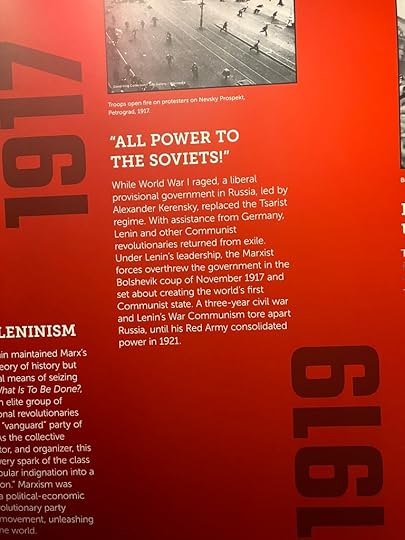
I had a slightly more serious quibble with this display which says that the ‘Soviet Red Army invaded Poland.’ This indeed it did, but not until after the Polish army invaded Soviet territory. This display would probably make most readers think that the Soviets started the Polish-Soviet war by launching an unprovoked attack on Poland, which isn’t entirely accurate.
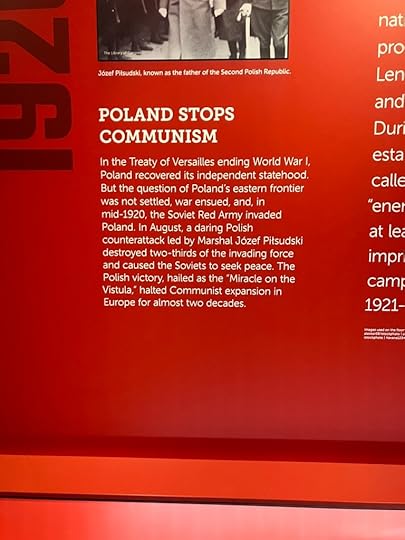
Poles pop up again in this discussion of the Great Terror. On the one hand, the museum has done a good job in not exaggerating the scope of the terror. Indeed, the quoted number of deaths – 700,000 – is on the lower end of what current scholars believe the death toll to have been. I was struck, though, by the claim that nearly a third of victims of the Great Terror (200,000 people) were Poles. It is indeed true that Poles were disproportionately targeted during the Terror. But the number more normally cited is around 120,000. I think that the museum should probably stick with the numbers that are most commonly recognized.
Likewise, there seems to be exaggeration in this display that claims that 70% of the population of Kazakhstan died in the famine of 1932-33. Sarah Cameron, author of a widely-acclaimed book on the topic, puts the total at about one-third of the population. Again, that’s terrible enough, but it’s also far removed from 70%. I don’t know where the museum got that number from and it may need revisiting.
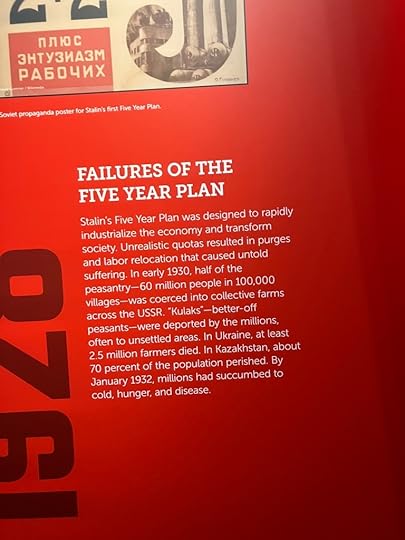
And there’s this panel, which gives a long list of nationalities whose members were ‘sent to the Gulag or other forced settlement areas of the USSR’. Russians are notably absent from the list, though of course very many of them were sent to the Gulag too. Now, it’s true that Russians were not targeted for deportation in toto in the manner of Crimean Tatars or Chechens, but neither were many of the other nationalities mentioned here. Soviet nationality policy also can’t be reduced to efforts ‘to destroy culture and impose conformity’. The Soviets invested a lot of resources into supporting minority languages (in some cases, creating alphabets and providing the first ever schools and literature in that language). Periods of Russification alternated with periods of ‘indigenization’, in which minority cultures were actively promoted and members of minorities given preference in their own republics. Soviet nationalities policy was much more complex than shown here.
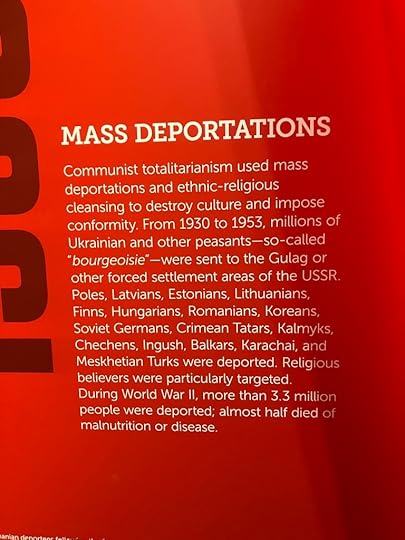
Then we come to a bit of historical revisionism about the start of the Second World War:
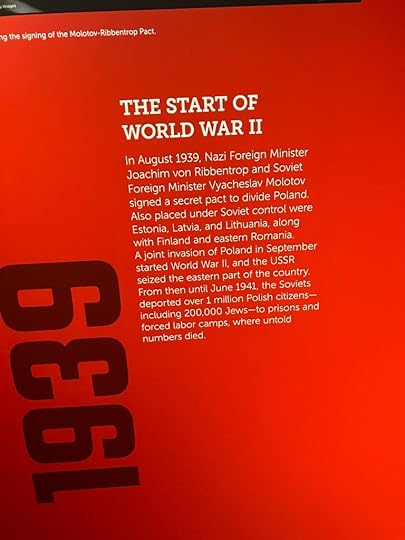
To my mind, it’s not accurate to say ‘a joint invasion of Poland in September [1939] started World War II.’ The British and French declared war on Germany on 3 September. The Soviets didn’t enter Poland until 17 September, two weeks later. Now, it’s true that they were already committed to doing so before then, but the British and French didn’t respond to a ‘joint invasion’ of Poland, but to a German one.
Then, we come to the naming of Russians, as in the two panels below. The first is a quote from a Hungarian priest calling for ‘Russian troops’ to leave Hungary in 1956. The second is a mention of the ‘Russian’ army leaving the Baltic states in 1994. The two panels are entirely accurate. But it strikes me that the language used could serve to conflate the Soviet Union and Russia in the mind of any visitor who didn’t know the subject well. It thus reinforces the idea of Russians as perpetrators not as victims.
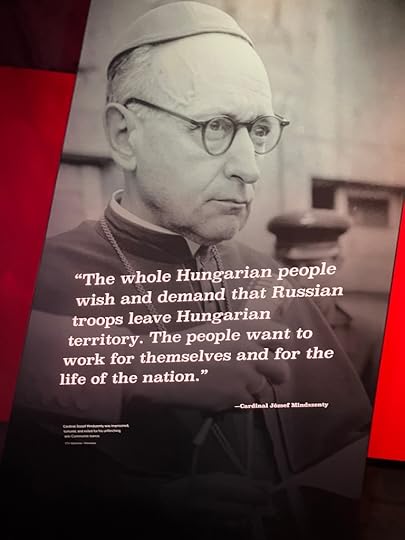
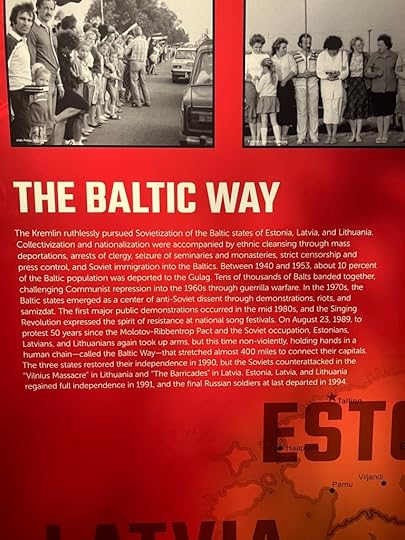
Overall, I would say that it is an interesting place to visit and a younger generation of visitors who know nothing about communism will learn much from it. That said, I have my doubts about museums and monuments focusing entirely on the victims of communism. This isn’t because I am remotely sympathetic to communist theory or practice. Far from it. It’s very correct that people should be reminded of the horrific crimes committed by communist regimes (as they should be of the crimes committed by regimes of other types). But when all you look at is that, it becomes very hard to explain things such as modern-day Soviet nostalgia. It also makes one wonder why on earth anybody would have supported such an ideology. Thus, while the Museum of the Victims of Communism will teach you an important part of the history of communism, one should bear in mind that it is indeed only a part.
October 6, 2025
Is NATO About To Attack Russia? Kim Iversen Interviews Former US Intel Officer Rebeka Koffler
I’ve seen Iversen interview Koffler before on her show and I wasn’t sure what to make of her. I’ve concluded that she’s a mixed bag – some things she says are accurate and/or interesting and other things are not, such as her characterization of the Russian-Chinese partnership. Let me know what you think of her in the comments. – Natylie
YouTube link here.
October 5, 2025
Russia Matters: Putin Insists There’s No Plan to Attack NATO, Warns of Escalation Over Tomahawks for Kyiv
Russia Matters, 10/3/25
Donald Trump recently signed off on allowing intelligence agencies and the Pentagon to aid Ukraine with long-range missile strikes on Russia’s energy infrastructure, and U.S. officials are now asking NATO allies to provide similar support, The Wall Street Journal reports. “It is the first time, officials say, that the Trump administration will aid Ukrainian strikes with long-range missiles against energy targets deep inside Russian territory,”1 according to this newspaper. In addition, the Trump administration is considering Kyiv’s request for Tomahawk cruise missiles, one of the most precise U.S. weapons, which have a range of around 1,500 miles, WSJ reported. JD Vance disclosed that the U.S. was considering Ukraine’s request this past weekend, prompting Vladimir Putin’s spokesman Dmitry Peskov to ask, “The question remains: Who can launch these missiles, even if they end up on Kyiv regime territory? Can only Ukrainians launch them, or will the American military do so?” Peskov’s boss also warned the U.S. against supplying Tomahawks in his remarks on Oct. 2. Putin said that deliveries of U.S. Tomahawk missiles to Ukraine would mark a “qualitatively new stage of escalation,” triggering a fresh crisis in U.S.-Russian relations.2 In his reaction to these developments, Harvard University Professor Graham Allison warned that the “dangers [may] move up the escalation ladder.” “Now we will see whether the U.S. actually does it. And if so, how Russia responds,” he wrote in a short commentary for RM. NATO must step up its response to Russia’s hybrid war, which is “only the beginning” and is aimed at dividing Europe, Danish Prime Minister Mette Frederiksen said, following recent drone incursions that shut down Denmark’s main airport and which Copenhagen suspects may have been staged on Moscow’s orders. Following the incursions, which Financial Times reported to have also shut down multiple military locations, Denmark announced it would acquire long-range precision-guided weapons to deter Russian aggression and align Danish capabilities with larger NATO allies. Frederiksen claimed this move will represent a “paradigm shift in Danish defense policy.” “I hope that everybody recognizes now that there is a hybrid war… there is only one country… willing to threaten us, and it is Russia, and therefore, we need a very strong answer back,” Frederiksen was quoted by WSJ as saying. In his turn, Russia’s ambassador Vladimir Barbin called Denmark’s reaction “pure madness” and a threat against Russian targets. “No one, anywhere in the world, has ever considered publicly threatening a nuclear power,” Barbin warned. “From now on, we will have to assume that Denmark not only considers the possibility of a direct military confrontation with Russia, but is preparing for such a scenario,” the Russian diplomat said. In his reaction to these developments, Harvard University Professor Graham Allison wondered whether and which NATO members would be prepared to do anything that would increase the risk of Russia striking back. In his reaction, Allison focused on Denmark. “Denmark is clearly waking up. The question is what are they prepared to do? And my bet is that it will mostly be talk,” he wrote in a short commentary for RM. In his annual address to the Valdai Discussion Club on Oct. 2, Putin dismissed Western warnings of a Russian attack on NATO as either incompetence or dishonesty, urging European leaders to “calm down.” He claimed the Russian armed forces are confidently advancing along multiple axes in Ukraine and dismissed Trump’s descriptions of Russia as a “paper tiger,” asserting that Moscow is managing to fight not just Kyiv in Ukraine, but the whole NATO bloc. As stated above, in his remarks, Putin also warned that deliveries of U.S. Tomahawk missiles to Ukraine would mark a “qualitatively new stage of escalation,” triggering a fresh crisis in the U.S.-Russian relations. Putin also asserted that Russia remains confident in its nuclear deterrent, but has again reiterated Moscow’s recent proposal for Russia and the U.S. to jointly extend the central limits of the New START treaty before it expires in February 2026. He also warned Russia would resume nuclear tests if another nuclear power does so and repeated Russia’s long-standing position that U.S. calls for trilateral U.S.-Russia-China nuclear arms control negotiations will fall flat unless, among other things, the arsenals of Britain and France are factored in.3 That Putin and his foreign minister Sergei Lavrov have both urged the U.S. to consider Russia’s recent proposal to extend New START limits thrice in the past week and a half indicates that the Kremlin is now keen to preserve some semblance of nuclear arms control with Washington even as Russian leaders have not heard from Trump on the issue so far.Russian missiles have increasingly evaded Ukraine’s U.S.-made Patriot air defenses, with officials saying upgrades allow Iskander-M and Kinzhal missiles to alter trajectory and perform end-phase maneuvers that “confuse and avoid” interceptors, Financial Times reported.Shipments of Russian nuclear fuel to the U.S in monetary terms amounted to slightly less than $800 million in 2024, and they are expected to reach around $1.2 billion in 2025, according to Putin. Russia remained the top supplier of nuclear reactor fuel to the U.S. last year, data from the U.S. Department of Energy shows. Russia provided 20% of the enriched uranium used in America’s fleet of commercial reactors, down from nearly 27% in 2023, according a Sept. 30 report by the EIA cited by Bloomberg.Uriel Araujo: Nuclear Poland? Between proxy and atomic power
By Uriel Araujo, InfoBrics, 9/26/25
Uriel Araujo is an Anthropology PhD, a social scientist specializing in ethnic and religious conflicts, with extensive research on geopolitical dynamics and cultural interactions.
Polish President Karol Nawrocki has recently stated on French channel LCI that “Poland should be part of the nuclear sharing program, it should have its own nuclear capabilities: energy and military”, as part of “Polish-French partnership.” Nawrocki added that, in the future, Warsaw could be “developing Poland’s own nukes” .
This rather underreported call for NATO’s nuclear-sharing program aligns, in a way, with US assurances to Poland and Estonia for bolstered Baltic defenses. Moreover, this development in fact signals a pivotal shift: Warsaw is no longer content with conventional arms but eyes atomic capabilities as a security cornerstone.
Back in June 2023 then Prime Minister Mateusz Morawiecki was already expressing Warsaw’s interest in hosting NATO’s nuclear weapons under the Alliance’s nuclear sharing policy. And one may recall that early 2025 set the stage for today, with then-President Andrzej Duda urging US nuclear warheads on Polish soil to shift NATO eastward, while Prime Minister Donald Tusk told parliament Warsaw must “reach for opportunities related to nuclear weapons” in a “race for security.”
Amid doubts over transatlantic “friendship” in face of Donald Trump’s presidency in Washington, these statements reveal to what extent Poland seeks a deeper geopolitical play.
For years, Warsaw has chafed under Germany’s shadow, the EU’s economic heavyweight. As a matter of fact, tensions have flared into rivalry, as I’ve written, revealing cracks in Western unity. In 2023, Poland blocked Ukrainian grain imports, undercutting Berlin’s softer stance on Kyiv, while pouring billions into a military buildup to outpace Germany’s spending.
Warsaw’s accusations of German “hypocrisy” on energy and migration cemented its role as Europe’s anti-Russian bulwark. Poland’s elite thus sees nuclear options as a path to autonomy, thereby sidelining Berlin’s influence.
The US, ever the puppeteer, has fueled these ambitions quite skillfully, grooming Poland as a proxy to shoulder containment burdens. This allows Washington to pivot toward Asia (or toward a neo-Monroeist “America First” or what not) while Warsaw plays frontline enforcer. A nuclearized Poland would fit this script, be it through NATO’s sharing program or French deterrent talks.
Suffice to say, such moves skirt the Non-Proliferation Treaty’s spirit but align with America’s selective hypocrisy, as seen time and time again, with Pakistan’s arsenal and elsewhere.
The implications ripple beyond Warsaw. A nuclear-armed Poland would turbocharge its leadership bid, potentially tightening ties with Ukraine. One may recall 2022’s talks of a Ukrainian-Polish confederation amid anti-Russian fervor, a topic on which I also commented at the time.
By 2024, strains had emerged — for one thing, Polish farmers blockaded borders over Ukrainian grain, and far-right voices demanded repatriating draft-age Ukrainians, amid joint calls to end Ukrainian refugee benefits. Yet, 2024 security pacts allow for Poland to intercept Russian missiles and drones over Ukraine, albeit conditionally.
Underreported is how nuclear ambitions could revive such confederation ideas, with Poland eyeing a “Three Seas” bloc to counter Russia (and Germany, by the way), thus enhancing the spectre of EU fractures. The 3SI Warsaw summit has been seen by many as a potential platform to integrate nuclear energy projects, such as small modular reactors, and security pacts, reviving bloc ambitions under the guise of “united Europe” against Moscow.
From a Russian perspective, a nuclear Poland would be an existential red line, akin to Ukraine’s NATO bid. Russia sees Poland as a revanchist threat, with Warsaw’s 2023 moves in Ukraine’s west fueling encirclement concerns.
Polish facilities in such nuclear scenarios could thus be a major source of tension, to put it lightly. Poland’s elite calls this deterrence, but Russia’s arsenal dwarfs NATO’s European holdings, and any “win” invites mutual destruction at best.It is worth noting Moscow already lowered its nuclear threshold, in late 2024.
America’s drive to offload Ukraine’s “burden” onto Europe amplifies these dangers. Even as Trump now claims Ukraine could “regain” disputed territories, the fine print shows European taxpayers footing the arms bill, as I’ve recently noted. Meanwhile, Poland’s RARS agency is under EU scrutiny for 2024’s overpriced procurement.
At this point, Washington’s $283 billion in Kyiv aid arguably pales against EU commitments, yet Trump demands Europe pay more, echoing past “freeloader” gripes. So much for burden-sharing; Poland, the eager proxy, absorbs costs and risks. Tusk’s call for a 500,000-strong army and nuclear options, with only 10,000 US troops as a symbolic shield, lays it bare.
Today, Trump’s backing of Poland (and Estonia, by the way) is classic leverage to “bully” adversaries, using “allies” to prod Moscow — a hallmark of his brinkmanship, so to speak.
Provocative enough to thrill hawks, this courts disaster in many ways, a region primed for escalation. Poland’s nuclear path is no defensive reflex but a bid for great-power revival, egged on by a US keen to “delegate”. The allure — deterrence, German rivalry checked, Ukraine’s orbit tightened — is clear, from a Polish perspective.
Yet the perils — alliance cracks, and fiscal strain; not to mention “cornering” Moscow — make it a dangerous enough gamble. And History rarely forgives such bets. Poland’s “race for security” risks in fact the very war it supposedly aims to avert.
October 4, 2025
PATRICK LAWRENCE: A Nation of Narcissists
By Patrick Lawrence, Consortium News, 9/9/25
All those malign authoritarians, more than 20 of them, who gathered in Tianjin at the end of August for a summit of the Shanghai Cooperation Organization: This was a festival of anti–Americanism, you need to know.
No other way to understand it. Making it all worse, Xi Jinping then invited more than two dozen heads of state to Beijing to mark the 80th anniversary of the 1945 victory.
How dare the Chinese president organize an elaborate military parade to celebrate China’s role in the historical defeat of the Imperial Japanese Army. How dare he stir pride in the People’s Republic’s determination to defend its sovereignty while refuting the revisionism — nonsensical but prevalent — that airbrushes the Chinese Communist Party out of the Second World War’s history.
The temerity of this man to suggest it was other than the Americans and their corrupt clients, the Chinese Nationalists, who did the fighting and won the war. Let us not, for heaven’s sake, make any mention of the 12 million to 20 million Chinese — there is no precise figure — who died in consequence of Imperial Japan’s aggressions.
No, nothing to honor in any of this. Between the S.C.O. and the festivities in Beijing it was all faintly demonic, a thinly veiled challenge to what the United States and the rest of the West insists is a “rules-based order.”
I keep a file labeled “Sentences to love in The New York Times.” From it: “It shows how Mr. Xi is trying to turn history, diplomacy and military might into tools for reshaping a global order that has been dominated by the United States.”
The mainstream reporting on the S.C.O. and the subsequent gathering in Beijing went on obsessively for days. You would think the Chinese were on the brink of starting another Pacific War and “invading” Taiwan—“invading” in quotation marks because a nation cannot invade territory that historically belongs to it.
As I read through the coverage I marveled at the wall-to-wall West-centricity of it. The Chinese, the Russians, the Indians, various others, even the North Koreans: They think of nothing and do nothing that does not arise from their all-consuming animosity toward the United States and altogether the West. So you read in the reporting of these events.
Then along came Donald Trump, who addressed Xi on his Truth Social platform with this, referencing the Russian and North Korean leaders as he watched the proceedings live: “Please give my warmest regards to Vladimir Putin and Kim Jong Un as you conspire against the United States of America.”
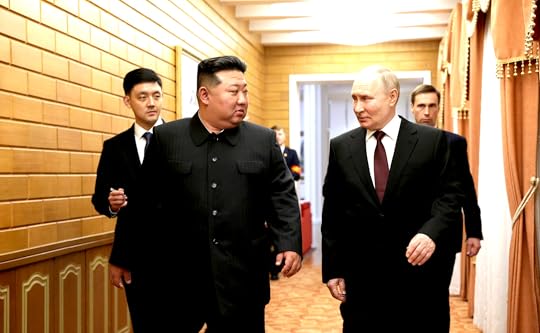
North Korean leader Kim Jong-un and Russian President Vladimir Putin in Pyongyang on June 18, 2024. (President of Russia)
There is no beating the Trumpster when it comes to stating the case forthrightly. The mainstream press can strike the pose of objectivity all it likes, but Trump, the id of the late-phase imperium, comes right out and says it: The non–West is against us. Anti–American animosity is its sole motivation, its very raison d’être.
I write here not of our dissolute press, whose mission these past two dozen years — I take the events of September 11, 2001, as the point of departure — has been to prevent Americans from seeing and understanding the 21st century’s realities. Neither is the blunt instrument now lodged in the White House my topic.
No, the press and the president are merely exhibits, symptoms of a national failing that transcends either of these. This is the problem of America’s self-absorption, the pervasive narcissism that, it now becomes evident, is a primary cause of our troubled republic’s increasingly hostile relations with others and, so, its swift descent into isolation.
In Ovid’s Metamorphosis, Narcissus is a youth of transcendent beauty who spurns Echo, the nymph who loves him, and becomes infatuated with his own reflection in a pool of water. He thereafter takes to rejecting all admirers.
Narcissus is thus blind, but not only to others: He is also blind to himself. This fulfills the prophecy Tiresias made on his, Narcissus’s, birth: He will live long, the mythical seer said, “so long as he never knows himself.”
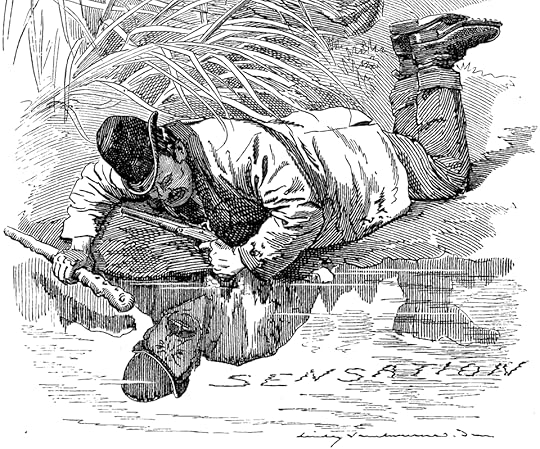
The Newest Narcissus; or, The Hero of our days, a cartoon by Edward Linley Sambourne, Punch, or the London Charivari, April, 1892. (Project Gutenburg, Public Domain)
Narcissism is the open-and-shut condition of the elites who fashion and execute American foreign policy. They see only themselves when they look abroad at others. And they are utterly incapable of seeing themselves as they are or their country as it is.
It is dangerous to be America’s enemy, Henry Kissinger once remarked in an often-quoted comment, but it is fatal to be America’s friend. This is the United States as run by the narcissistic cliques who set the imperium’s course. Nothing and no one matters beyond their own power.
I think too much of Americans to assign this condition to them out of hand. No, it is the media’s task to impose this condition on Americans. Consider again how the press covered Tianjin and Beijing: We are encouraged in every sentence to see our reflections in those events, for they were all about us.
Read a few of these pieces carefully, I urge. You find correspondents in this or that bureau abroad who rarely quote Chinese or Russian or even European sources in support of the reporting. No, they call reliably conformist scholars or think tank denizens back in the States to tell them how to think about what is going on in China or Russia or wherever it may be.
See what I mean? Journalism this flaccid is a new one on me. If it is not American narcissism as it is in practice I do not know what else to call it.
Did you read anything in the American press about Xi’s proposal for a “Global Governance Initiative” to assist in the pursuit of a more just and equitable world order?
What about the Chinese leader’s announcement in Tianjin of a new S.C.O. development bank, grants of 2 billion renminbi, $280 million, to S.C.O. members, and an additional 10 billion renminbi, $1.4 billion, in loans?
Or his speech calling for the historical record of the Pacific War — corrupted precisely as the West cravenly erases the Soviet Union’s decisive role in defeating the Reich — to be corrected?
Let me help you out. No, no, and no. The policy cliques are indifferent to these things and you are meant not to see them, blindness to our world the preferred condition. The policy people in Washington have been captivated by their own reflections ever since they set out to achieve global dominance almost immediately after the 1945 victories.
And so long as American power was hegemonic this did not matter. Diplomacy, as Boutros Boutros–Ghali memorably remarked after the United States forced him as out as the U.N.’s sec-gen, is for the weaker nations; the strong have no need of it.
There is need of it now, to state the obvious. And we find America to be self-blinded, stumbling, uncomprehending, and altogether incapable in this, a century of swift and momentous change.
Washington’s prevalent narcissism renders proper statecraft more or less impossible, as there has been, just as Boutros–Ghali astutely observed, no need of it for most of the past eight decades. And we cannot put this down to Donald Trump alone: This has been less obviously but just as true of the administrations that preceded his.
“[W]e find America to be self-blinded, stumbling, uncomprehending, and altogether incapable in this, a century of swift and momentous change.”
At this point the late-phase imperium is more or less entirely dependent on force as its mode of expression in the community of nations.
Parenthetically, this is how I read the Trump regime’s stunning decision to rename the Defense Department the War Department, just as it was called until 1949, when it was judged necessary to veil the arriving era of America’s imperial aggressions.
Military force, increasingly vicious varieties of coercion, sanctions that amount to collective punishment, in the case of Palestinians the refusal of visas: It is all Washington can think of doing as it responds so defensibly to the 21st century. It will, of course, lead nowhere but to further isolation and decline.
At a press conference in Beijing last Tuesday, as the days of diplomacy and celebration drew to a close, a correspondent asked Vladimir Putin what he thought of Trump’s “Say hello as they conspire against us” remark on Truth Social. The Russian president’s reply was a model of statesmanship and clear thinking:
“The president of the United States is not devoid of humor — everything is clear, everyone knows it well….
I can tell you, and I hope he will hear it as well: It may seem strange, but during these four days of negotiations, both informal and formal, no one has ever expressed any negative opinions about the current American administration….
The activities of the SCO and those of our partners, including our strategic partners, are not aimed at fighting anyone, but rather at finding the best ways to develop ourselves, our countries, our peoples, and our economies.”
It is a point that cannot be made too often, so commonly is it missed. The emergence of the non–West as a bloc of nations has not a shred of anti–Americanism in it. These nations would indeed welcome the United States, with its capital, its technologies, and so on, to participate fulsomely in building the new world order to which they are dedicated.
Only hegemons are unwelcome in this decidedly ecumenical undertaking. Only narcissists. Whether or not America can at last stop staring at its own reflection to see the world around it will determine its fate in our evolving century.
Patrick Lawrence, a correspondent abroad for many years, chiefly for the International Herald Tribune, is a columnist, essayist, lecturer and author, most recently of Journalists and Their Shadows, available from Clarity Press or via Amazon. Other books include Time No Longer: Americans After the American Century. His Twitter account, @thefloutist, has been restored after years of being permanently censored.
October 3, 2025
Izvestia: EU split grows over proposal to fund Ukrainian ‘reparations loan’ with frozen Russian assets
TASS, 10/2/25
The division within the European Union is intensifying over a new initiative to establish a reparations loan for Ukraine backed by Russian holdings. German Chancellor Friedrich Merz has urged Brussels to abandon excessive bureaucracy, while French President Emmanuel Macron and Belgian Prime Minister Bart De Wever warn of breaches of international law. Yet, only days earlier, France and Germany, within the framework of the Weimar Triangle, had voiced support for the idea of employing Russian assets. Attempts to seize Russian property will trigger a painful mirror response, the Russian Foreign Ministry told Izvestia.
“Whichever option Brussels ultimately chooses, manipulating frozen sovereign assets without Russia’s consent constitutes a gross violation not only of international law, but also of contractual law. Russia has not authorized any such operations. Actions that involve altering the legal status of Russian assets will no longer mean a freeze, but rather the unauthorized management of foreign property – in other words, essentially theft,” the Russian Foreign Ministry told Izvestia.
“The overwhelming majority of experts argue that the risks of outright confiscation for the dollar and euro systems are far greater than the potential benefits from employing these funds – primarily because of the precedent it would set and the erosion of trust in the financial jurisdiction of Western countries,” Senior Research Fellow at the Institute for International Studies of MGIMO, Russian Ministry of Foreign Affairs, Egor Sergeyev told Izvestia.
“In the short term, no consensus on this matter can be reached, if only because none exists even within the European Union. And in the United States, even under the Biden administration, it has been concluded that from a legal standpoint, this scheme is extremely precarious,” a leading expert at the Russian Institute for Strategic Studies Pavel Zakharov told the newspaper.
According to Vladimir Vasiliev, Chief Research Fellow at the Institute for the US and Canadian Studies, Washington is unlikely to risk its reputation over $5 bln, but may well push Europe in that direction – in which case European capital will begin to flow into the United States.
“The initiators and participants of expropriation measures are guaranteed to face consequences. Moreover, in accordance with the principle of reciprocity, attempts to seize Russian property will provoke a painful retaliatory response. Russia has at its disposal a sufficient arsenal of countermeasures and the ability to deliver an appropriate political and economic answer,” the Russian Foreign Ministry told Izvestia.
First, the measures could be legal in nature, since what is at stake is a violation of international law. Second, the response could be purely economic. Moscow has already developed a system of specific steps, such as temporary management of the property of companies from unfriendly states, or the transfer of such assets to state ownership or to the Central Bank as compensation for any seizures, the newspaper writes.
***
Russia Drafts Plan to Seize Assets If EU Acts on Funds (Excerpt)
Bloomberg, 10/2/25
Russia may nationalize and swiftly sell off foreign-owned assets under a new privatization mechanism in retaliation for any European moves to seize Russian holdings abroad, according to a person close to the government.
President Vladimir Putin on Tuesday signed an order allowing for fast-track sales of state-owned assets under a special procedure.
The decree is intended to speed up the sale of various companies, both Russian and foreign, the person familiar with the matter said, asking not to be identified because the information isn’t public. Should the European Union begin seizing Russian assets, Moscow may respond with symmetrical measures, the person said.
Hundreds of western companies working in sectors from banking to consumer goods still operate in Russia, including UniCredit SpA, Raiffeisen Bank International AG, PepsiCo Inc, and Mondelez International Inc.
Putin acted as EU leaders meeting in Denmark build momentum for a plan to provide Ukraine with €140 billion ($164 billion) in loans from immobilized Russian central bank assets, ahead of a formal summit at the end of this month….
***
Belgium Pours Cold Water on EU Plan to Use Russian Frozen Assets (Excerpt)
Bloomberg, 10/2/25
The European Union’s bid to unlock funding for Ukraine from frozen Russian central bank assets faced resistance as Belgium raised legal questions about the plan to raise financing from up to €185 billion ($217 billion) held on its territory.
Belgian Prime Minister Bart de Wever called the EU proposal to tap interest from the Russian assets a “big gamble” that required ironclad risk-sharing among EU member states. He signaled that the process would be time consuming, suggesting the bloc seek alternative financing for Kyiv.
“Every country will have to guarantee proportionally in the case that this goes wrong,” De Wever told reporters Thursday on the margins of a European Political Community summit in Copenhagen. The EU asset plan entails “huge amounts of money,” requiring guarantees for “a very long time,” he said.
EU leaders who gathered for a meeting Wednesday in the Danish capital offered a more upbeat assessment, saying that the bid to raise billions for war-battered Ukraine is gathering momentum and concerns would be allayed. European Commission President Ursula von der Leyen assured that the risks tied to the plan would land on “broader shoulders.”…
Joe Blank: My Whole Thing with Ukraine
By Joe Blank, Buy Me a Coffee, 9/13/25
As some of you who know me through social media might be aware, I have spent the past 3 1/2 years of the Ukraine war as someone who is extremely against the idea that America (or anyone, for that matter) support Ukraine in the current conflict with Russia. It’s a bit of a story, but I rarely get asked why I feel this way. Rather, most simply prefer to jump to the conclusion I’m MAGA or a Russian agent. I am neither. I’m an American, a Southerner, of Scots/Irish ancestry. I’m politically unaligned, as I value some ideas both traditionally held by the “left” AND the “right”. Heck, prior to 2022, the only Russians I spoke to were a nice married couple I used to work with and a fellow artist I met on Instagram. Definitely not on the Kremlin payroll.
No, I’m just – for this purpose, at least – your average American Joe.
And yet, I find myself coming to a point where I have the names of Azov commanders memorized. Stephan Bandera quotes. Specific amounts of aid provided and the dates the bills were passed by Congress. It’s a bit much. Until the other day, I really had been plunging back into history trying to remember HOW I became so invested in the subject in the first place. And then it hit me.
RT America. Russian news.
Now, before you jump the gun and use this as a “Gotcha, Putin puppet!”, do allow me to explain.
You see, I have always been someone who has deeply cared about our First Amendment rights. In 2013, if you’ll remember, there was a little bit of drama with a guy named Edward Snowden, who released information that I found deeply disturbing to say the least. Not necessarily surprising, but that didn’t matter. The basic premise was out. Your government watches you, sometimes for no specific reason.
It was at this point in my life I think I truly began to appreciate the information sphere that we live in as Americans, honestly. As far as the only two cable television news stations I had access to at the time, only Al-Jazeera and RT News were the ones reporting up-to-date information about his currently known location. They were the only ones actually highlighting the information Snowden had helped bring to light. It really taught me that, when looking for information critical of what your own government is doing, you have to look outside that bubble.
I continued to watch RT then, probably for the next year regularly. So when the Maidan began, initially, I got the Russian perspective. Did that color my initial impression of the Ukrainian state? Not really. Just as I understood that American media isn’t exactly putting out 100% of the story, I assumed the same with Russia and Ukraine. Cynic that I am. But by that time I had already developed a crush on Abby Martin so I kept RT going in the background while i did other things and it was by no means my exclusive venue for news. I have no complaints about it at all as a news organization, personally, but want to emphasize simply that it was one source of many I used to form an opinion.
At that time, too, I was lucky enough to be in a career where – as long as you could multitask on dual monitors and keep off NSFW sites – you could entertain yourself however you pleased. I was a trained researcher in my field. Learning about politics, propaganda, and general skullduggery by “the man” has always been a hobby. Put the two together, I began really looking into the country and the rhetoric coming out of the Obama administration in the aftermath. The “Red Line”, as it were. Why were we so involved and what purpose did it serve America to get involved in, what up until that point, I had considered a civil war in Ukraine?
At that point, I’d already seen the Obama administration doing horrific things abroad and at home. I had been in the brokerage industry during the bailouts and saw the American middle class gutted. And, as I said, was aghast at the privacy and free speech concerns raised by the Snowden leaks. Crimea came and went, thankfully, without escalating to a full blown war between nuclear superpowers. But still, what was driving this?
So, whenever I would come across some news item from Ukraine (wasn’t exactly as if I gave it that much attention) I’d look into it. I wanted to know whose story was more true – the Russian or the American version. And those, I would say, are my formative years becoming the would-be armchair advocate for not supporting this state.
You see, when Biden first admitted that he was withholding a billion dollar grant to Ukraine unless they fired a certain prosecutor, I found that curious as well. Why would our government be dictating who they’d appoint to a specific job like that? Why are we even giving them a billion dollars? It wasn’t hard at the time to verify that Ukraine had, since it left the USSR, been a notoriously underdeveloped and corrupt country. By this time as well, it wasn’t hard to find plenty of Western-sourced articles which would confirm this, among other nasty facts about the country. Azov, ethnic nationalism, and the glorification of WW2 German collaborators. A history of human trafficking. Cheap sex tourism. And for some reason the Vice President, whose unqualified son is working on the board of a Ukrainian energy company, is just handing over that kind of cash, with caveats.
Just seemed all a bit….odd….
There was probably a lull, I’d say, after Trump had his issues with Ukraine, that I really stopped paying attention. Whether Russia had invaded with “little green men” as they’re accused of, or not – it was just the Ukraine. Not exactly a big deal at that point. Sure, we’d thrown them a few weapons – but ultimately it was up to Ukraine and Russia to be sorted out. There were no overt signals from the American government that it would escalate this war further than it need be, and that was enough for me.
Well, that didn’t last long, did it? Biden was elected and, within a year, Russia’s “Special Military Operation” began. If you think America providing Ukraine a billion dollars of our taxpayer’s money in 2016 (when Americans were obviously already struggling and our social safety net was virtually nonexistent) then imagine my utter disgust when the first $13b was passed in Congress, or the $40.1b package passed a couple months later. Couldn’t this money, suddenly found for Ukraine, be used for a better purpose at home?
That’s a question that bothers me, and if you’re any kind of an American, should bother you. We live in a nation with an estimated one million homeless (which I believe is still a lowball number). and have spent over $200 billion combined between federal funding packages and loans financed through the IMF and World Bank (minimum, as no one seems to really know the exact figure). Simple math tells you that COULD have been $200 [billion] put toward housing and mental care, resources for our entire homeless population – every man, woman and child. Why is Ukraine worth that, but the needs of the American people – the least of us – are ignored?
And I think, what has this really gotten us, as a country? Certainly not like every move made should be dependent upon our profiting from a situation, necessarily, but since the war began. it’s done nothing but antagonize other world powers, cost us money, and uprooted any sense of American hegemony left. You look at anything in America today versus 2021, a year prior to the war. Rent costs more. Food costs more. Gas. Electricity. Why should we be consumed with what’s happening in a distant Eastern European former Soviet country that has no substantial cultural ties with us, we have no long-lived allegiance with, nor any major strategic interest in?
I think some things are fairly obvious. Given that the Nordstream pipeline, the pipeline from Russia that fed Slovakia and Poland has been destroyed, and the fact the news was released today that Trump will only increase sanctions on Russia if Europe foregoes all Russian oil and only purchases from America or our approved list of partner states, that this has been a war specifically to increase our gas exports and maintain leverage over Europe. Right now, Trump is making overtures to Russia that our relations could be normalized, potentially playing both sides to his advantage. Either way, our sales to Europe have drastically increased since 2022 and most European nations have spent the past 3 1/2 years doing nothing but threatening and sanctioning Russia. They aren’t likely to return to their supply quickly if the war were to end tomorrow, would they?
But, this is Trump. Whichever way he thinks the wind is blowing at any particular moment – whatever his Mar-a-Lago guests are telling him – it’s a question up in the air. It continues to vex the EU, NATO, Ukraine, everyone involved, because it could go one way or another.
Also, it almost goes without saying, this was used as an upwards transfer of wealth to the weapons manufacturers. Some will use the tired old line of “but it benefits American industry” which no, no it really doesn’t. Not as a whole. Just that one facet of it, and largely the people that receive the most benefit are the already-wealthy shareholders. I argue, wouldn’t it have been more beneficial to Americans and our economy to pay John Deere or an American farm equipment company to provide tractors and the like to struggling American farmers instead of buying tanks and sending them to Ukraine. So much we could’ve done. But, unfortunately, ever since – well – forever – the beast of American defense contractors must be fed. It’s been that way all my life, really, especially since 9/11. They pay our politicians of both parties through lobbyists and campaign contributions, and they expect their back scratched in return.
So that’s my story. That’s how I came to hold the position that I do. Roughly. I could regale you with so many tales of corruption, theft, moral depravity, and the absence of ethics when it comes to this subject, but I am going to [stop] here. I just want to leave you with the understanding of why I am against further aid as a solution to this conflict. Why I feel allowing Russia and Ukraine to sort their own problems out is the most beneficial thing we could do, as Americans and indeed as human beings.
Thanks for reading. If for some crazy reason you enjoy what I write, I do appreciate any tips that you might drop my way. Please do check out my art in the gallery here as well, and feel free to follow or reach out to me on Twitter at @therevjoeblank.
October 2, 2025
Reuters: US Tomahawk missile shipments to Ukraine unlikely, sources say
By Mike Stone, Reuters, 10/2/25
WASHINGTON, Oct 2 (Reuters) – The Trump Administration’s desire to send long-range Tomahawk missiles to Ukraine may not be viable because current inventories are committed to the U.S. Navy and other uses, a U.S. official and three sources said.
U.S. Vice President JD Vance said on Sunday that Washington was considering a Ukrainian request to obtain long-range Tomahawks that could create havoc deep into Russia, including Moscow. On Wednesday, Reuters reported, the U.S. will provide Ukraine with intelligence on long-range energy infrastructure targets in Russia.
But a U.S. official and sources familiar with Tomahawk missile training and supplies questioned the feasibility of providing the cruise missiles, which have a range of 2,500 kilometers (1,550 miles).
The U.S. official stressed there was no shortage of the workhorse weapon, which is often used by the military for land attack missions, suggesting other shorter-distance options could be supplied to Kyiv.
The official said the U.S. may look into allowing European allies to buy other long-range weapons and supply them to Ukraine, but Tomahawks were unlikely.
SHIFT IN STANCE BY TRUMP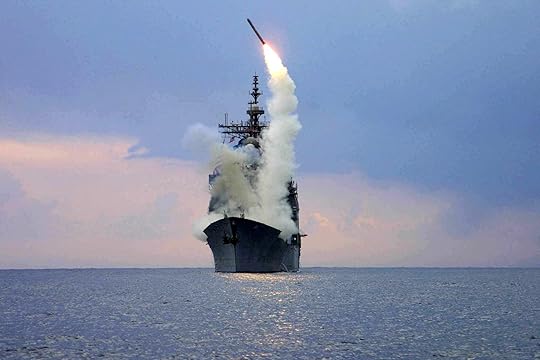
In recent weeks, U.S. President Donald Trump has sharply shifted how he talks about the war in Ukraine, suggesting Kyiv could retake all the land Russia has seized and calling the Russian military a “paper tiger.” The U.S. decision to help Ukraine target Russian energy infrastructure appears to be one tangible outcome of the new stance.
A new financial mechanism, the Prioritized Ukraine Requirements List (PURL), has been developed by the U.S. and allies to supply Ukraine with new weapons and those from U.S. stocks using funds from NATO countries.
Supplying Tomahawk missiles to Ukraine could significantly expand its strike capabilities, enabling it to hit targets deep inside Russian territory, including military bases, logistics hubs, airfields and command centers that are currently beyond reach.
The Kremlin said on Thursday that if the U.S. provides Tomahawks to Ukraine, it would trigger a new round of dangerous escalation between Russia and the West.
According to Pentagon budget documents, the U.S. Navy, the primary user of the Tomahawk, has thus far purchased 8,959 at an average price of $1.3 million each.
The Tomahawk missile has been in production since the mid-1980s. In recent years, production has ranged from 55 to 90 per year. According to Pentagon budget data, the U.S. plans to buy 57 missiles in 2026.
Russia said on Monday that its military was analyzing whether or not the United States would supply Tomahawk cruise missiles to Ukraine for strikes deep into its territory.
'Can American 'Tomahawks' cause us damage? They can. But we will shoot them down. Will this damage our relations with the USA? Of course. Using 'Tomahawks' without the direct involvement of American servicemen is impossible. This will be a completely new stage of escalation' –… pic.twitter.com/2hcrG6nrOl
— Zlatti71 (@Zlatti_71) October 2, 2025
I guess they just learned that it’s a ship-launched missile and Ukraine doesn’t have any ships. pic.twitter.com/DZZTFgSJVo
— Big Serge(@witte_sergei) October 2, 2025
Sylvia Demarest: Netanyahu says Israel must become an “Autarky.” This level of self-sufficiency would require war in the Middle East to create “Greater Israel”.
By Sylvia Demarest, Substack, 9/21/25
Introduction: A Short History of Western Colonialism, including in the Middle East
The discovery of the Americas in 1492 ignited what has been called “The Age of Discovery” and the creation of colonial empires across the world. Almost every European country established colonies in the Americas, Africa, and East Asia. These colonies were used to supply resources, raw materials and markets for home-based production. This resulted in the extraction of enormous wealth which flowed back to Europe. Many books have been written about this blood-soaked period of human history.
The most significant colonial empire was the British Empire. Britian used its navy to “rule the waves” for 275 years while small groups of British nationals controlled enormous populations in East Asia and elsewhere. The East Asia Company, at its peak, controlled 50% of global trade and was said to be worth $7 trillion in today’s dollars. How did the Brits manage this empire? By using both violence and strategies that kept the subject population too divided to organize effective opposition. What we call “the west” still depends on extracting wealth from the rest of the world. This means colonial thinking and the technique of divide and conquer continues to drive foreign policy.
How does this apply to today’s Middle East? Again, a short history is required. The Ottoman Empire existed from 1300 to 1923. It was centered on the Anatolia plateau, what is now Turkey, and included parts of Europe, the Middle East and North Africa. At its peak, the empire was noted for its advancement of artistic expression, literary works, and architectural milestones. It oversaw flourishing trade routes until it encountered rivalry from the East and Europe which gave rise to factions within the empire. One important aspect of the empire was its religious tolerance, which was not in the best interests of the western colonial empires that wanted to break up the Ottoman Empire.
The dissolution of the Ottoman Empire after WW1 resulting in the creation of several countries that exist today: Algeria, Tunisia, Libya, Egypt, Sudan, several countries in the Balkans in southeastern Europe, Turkey, Cypris, Saudia Arabia, Iraq, Syria, Lebanon, the Palestinian Mandate, and later, Israel.
The partition of the Ottoman Empire set the stage for today’s controversies in the Middle East. The agreements establishing the partition include The Sykes-Picot Agreement (1916), the Balfor Declaration (November 1917) and the Treaty of Sevres (1920), eventually replaced by the Treaty of Lausanne in 1923. Under these, sometimes secret agreements, the Ottoman Empire was partitioned and the British, and the French, gained control over Iraq, Saudi Arabia, Lebanon, Syria, and Palestine. The Balfour Declaration was incorporated into the British Mandate for Palestine, and the Brits helped to facilitate Jewish immigration into the area–ultimately resulting in the emergence of Israel in 1948.
At the time, the Brits were aware that Iran had oil but did not appreciate how much oil was in Iraq, or that there were enormous deposits of oil in what became Saudi Arabia in 1932. Oil was discovered in Saudi Arabia by expat, Max Steineke, Chief geologist at Casoc and Aramco in 1936.
The big issue, from the very beginning, was how to deal with and control, Arab nationalism. The British worked against the more moderate forms of Arab nationalism by forming alliances with Wahhabi elements represented by the House of Saud and providing them with military and financial support during their conflicts with the Ottoman Empire. Wahhabism emerged on the Arabian Peninsula in the 18th century founded by Mohammad ibn Abd al-Wahhab. The aim of Wahhabism was to reform Islam by denouncing practices seen as idolatrous. The British, seeking to weaken the Ottoman empire, aligned with Wahhabism going all the way back to 1744 because it was seen as a tool to advance British interests. In 1806 the Arabian tribal leader ʿAbd al-ʿAziz ibn Saʿūd seized Mecca. In 1932 of the state ofSaudi Arabia was founded as a modern Islamic state.
The point to be made is that the colonial powers, especially the British and the French but ultimately including the United States, played a major role in the rise of reactionary Arab regimes, which depended on the continued support of colonial and imperialist powers for their survival. The rise of reactionary Arab regimes split Islam by empowering the most radical form of Sunni Islamist fundamentalism, and by disempowering the more moderate forms of Islam, including Sunni Islam. This tactic successfully fractured Arab unity and, to this day, has prevented the consolidation of the Arab population into a world power.
Saudi Arabia, alone, has spent billions supporting the spread of Wahhabism through the construction of mosques around the world and by training and funding Wahhabi Iman to run them. This has resulted in the radicalization of an entire generation of Arabs, unbelievable carnage in the Middle East, and the creation of the image of Islam as a backward violent religion. This represents another successful use of the strategy of “divide and conquer” to control resources, and to protect both Israel and the reactionary Arab regimes.
The empowerment of Wahhabism ultimately led to al Qaeda, ISIS, Au Nusra and dozens of other Sunni Islamist gangs, all of whom have been supported by the Brits, the US, and an alliance of reactionary Arab regimes. The ultimate beneficiary has been western colonialism and Israel. The atrocities committed by these Sunni Islamists led to the “War on Terror”, the Patriot Act, the fall of secular governments in the Middle East, the rise of the Likud party and settler radicalism in Israel, along with our current panopticon of 24-hour total surveillance. The “War on Terror” and the label of “terrorist” or “terrorism” enabled the violation of civil rights at home, US wars for the security of Israel, and atrocities across the Middle East. Once a group or individual is labeled a “terrorist” all human rights are lost, and they can be killed. The labeling of Palestinian organizations, including Hamas as a terrorist group, has been used as an excuse to for the occupation of the West Bank and Gaza. More recently to flatten Gaza, make Gaza unlivable, and murder thousands of Palestinian civilians. An alternative interpretation under international law would be that Hamas is exercising Palestine’s legitimate right to resist the illegal Israeli occupation and theft of Palestinian land. The terrorist designation is by design, and it reinforces decades of propaganda focusing on “Israel’s right to defend herself” and “Israel’s right to exist”, while ignoring the fact that under international law, Palestine also has a right to exist, and Palestinians also have the right to defend themselves.
This centuries old pattern in the Middle East seems to be changing. This essay will discuss how and why.
The Yinon Plan, Clean Break, A New Pearl Harbor, and the dream of Greater Israel
In 1982 an article was published in a Hebrew journal by Oded Yinon, a former advisor to Areil Sharon and a journalist for the Jerusalem Post entitled “A Strategy for Israel in the 1980’s”. This article advocated accelerating the strategy of sectarian division of Islam discussed above. It called for the breakup and fragmentation of the Arab states into small, weak, ethnically and religiously defined states to enhance the security of Israel.
The “Yinon plan’ is claimed to have influenced the drafting of “Clean Break: A New Strategy for Securing the Realm” issued on 1996. The plan called for Israel to renew itself economically by leaving behind it’s socialist foundations and focusing on neoliberalism. It also called for Israel to adopt “preemption” as a military strategy, and to “broaden Israel’s base of support in the US Congress”.
In 2000 a group of neoconservatives surrounding George W. Bush described the need for a “new Pearl Harbor”. Soon after 911 occurred and the wars of the administration of George W. Bush began to take out 7 Middle Eastern countries in 5 years. The countries named were Iraq, Libya, Syria, Lebanon, Somalia, Sudan, and finishing off with Iran. The result has been what Richard Perle described as the beginning of waging “total war”. Over the last 24 years, Zionists and neoconservatives have overthrown several of the countries mentioned, destabilizing the Middle East, but failed to destroy Iran and had to, at least partially, withdraw from Iraq. Presently, Lebanon and Syria are under assault, and Israel is engaged in ethnically cleansing the West Bank and making Gaza unlivable. The UN has now characterized the Israeli attack on Gaza as a genocide.
Support for Zionism and for Israel is falling in the United States. US global military and economic hegemony is in decline. This implies the time frame for Israel to achieve her objectives in the Middle East, including creating a Greater Israel, is narrowing.
Greater Israel and its impact
On September 15, 2025, Prime Minister Benjamin Netanyahu proclaimed that Israel had to become an autarky, a modern Sparta. In August he gave an interview with i24NEWS, anddeclared his commitment to the vision of a “Greater Israel,” encompassing not only the West Bank but also parts of Jordan, Syria, Lebanon, Egypt, Saudi Arabia, Iraq, and Kuwait. The idea goes all the way back to Theodor Herzl and the founding of Zionism in 1896. The establishment of Greater Israel is required if Israel is to become self-sufficient. Here is a map of Greater Israel:
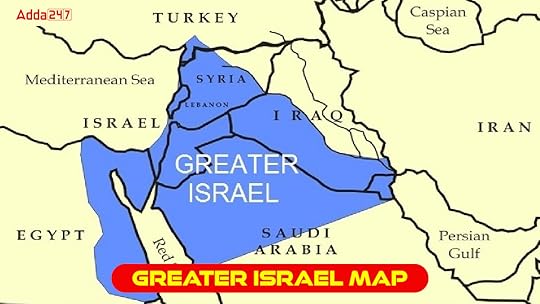
As you can see, Greater Israel includes the following:
–Egypt–the Sinai and everything up to the Nile including substantial resources along the Red Sea. Egypt has a peace treaty with Israel and is the recipient of a large amount of US aid. Egypt has yet to respond.
—All of Jordon. Jordon has been silent.
—All of Syria. Syria has been systematically destabilized. Jolani, the Jihadist who had a $10 million bounty on his head, has allowed Israel free rein to bomb and occupy Syrian territory.
—All of Lebanon including the water resources of the Litani River, the gas resources off the coast, Beirut, the mountains–everything.
—A good part of Saudi Arabia including much of the oil and other resources.
—Northern Iraq including the oil and other resources.
—All of Kuwait including the oil and other resources.
—Part of Turkey.
—Although not shown on the map, there are indications that the Zionists also want Cypris.
Putting aside for a moment whether a Greater Israel is realistic, we must assume that the conquest of Greater Isreal would resemble the conquest of Palestine. If so, terror techniques would be used to expel most of the population in each country, and the property and resources would be confiscated without any compensation. After all, Zionists owned only 7% of Palestine–the rest was seized without compensation. Israel is now attempting to depopulate and confiscate 109 square miles of Gaza, constituting prime Mediterranean property, and off-shore gas resources, again with US support and without compensation.
Obviously, Israel cannot achieve Greater Israel without US help. The US would have to pay for the wars, do the fighting, and the shed the blood and treasure to conquer the targeted countries. Can Israel manipulate the US into creating Greater Israel, as for the wars after 911? Does the US have the financial and military capacity to fight even one more war for Israel or have US militarism and Zionism finally gone too far?
The Israeli strike on the Hamas negotiating team in Doha marks the end of an era
Israel has been conducting “decapitation strikes” with impunity for decades. Here are just a few recent strikes:
—On October 17th and 18th, 2024 thousands of handheld pagers and hundreds of Walkie-talkies, assumed to be used by Hezbollah, suddenly exploded. This represented the use of ordinary commerce to achieve a targeted decapitation. At least 12 people were killed and over 3,000 were injured. Leon Panetta condemned the pager strike as “an act of terrorism.” Which is clearly true.
—On September 27, 2024, Israel killed Hassan Nasrallah, secretary general of Hezbollah, along with many others, as they were meeting under a residential building. The operation involved dropping more than 80 bombs on a residential neighborhood of Beirut, Lebanon. Nasrallah was killed for tying the Hezbollah cause to the Gaza war and seeking to include Gaza in a cease fire. Nasrallah is credited with ending the 18-year Israeli occupation of Lebanon in 2000.
—In the predawn hours of June 13, 2025, even as President Trump was advocating continued dialogue with Iran to resolve the nuclear issue, and another negotiation session had been scheduled, Israel launched a preemptive decapitation strike designed to take out Iranian civilian and military leadership. The strike included a massive attack of perhaps 200 fighter jets dropping 330 precision munitions on over 100 targets. The decapitation strike failed. The result was the 12-day war.
—On August 28, 2025 Israel conducted a decapitation strike that took out the entire Houthi civilian cabinet including the prime minister and 10 senior ministers.
—On September 9, 2025, as a Hamas team was gathering to discuss “the Witkoff Gaza proposal” in Doha, Qatar, Israel attempted a decapitation strike to take out the entire Hamas team. The team survived but again, like with Iran, the Hamas team was meeting in response to a peace proposal being pushed by President Donald Trump. Six people were killed including a Qatar security official. Qatar was not pleased.
Alastair Crooke calls the Doha strike “the end to an entire era–and a ‘new reality’ for Qatar”. This observation could extend to the entire Middle East if not the entire Islamic world.
Crooke points out that for decades Qatar had supported An-Nusra jihadists in Syria, against Iran (divide and conquer), while selling gas and maintaining US military bases and a strategic partnership with Washington. Doha was a mediator with a relationship with the jihadists while acting as a facilitator for Mossad. Now the idea that anywhere in the Middle East is a safe zone from Israeli strikes, or that the US would be a reliable defender, is over.
Israeli channel 11 reported that President Trump approved the attack and applauded any killing of Hamas members. This was yet another US/Israeli sneak attack–one that finally got through to the Arab countries that there are no forbidden territories; no rules of law; no Vienna Convention, and that the US and Israel would act as they pleased in the Middle East.
The unconditional US support “…for Israel’s genocide and ethnic cleansing; the failure to make any serious effort to prepare a political path for a settlement on Ukraine; the reliance instead on making war, whilst proclaiming peace – all these represent the essence of the Trump approach: An exercise of escalatory dominance, both at home and abroad.”
The impact of a US “Israel first” policy is fracturing Trump’s MAGA base as the reaction to the assassination of Charlie Kirk clearly shows. Worse, US policy has negatively impacted US soft power and diplomatic trustworthiness across the world, yet, for some reason, the Trump Administration cannot break free from Zionist domination. Meanwhile, Israel is increasingly out of control, carrying out a second Nakba (ethnic cleaning and genocide) in Gaza and the West Bank. At the same timees, Jewish society itself in Israel is trapped in repression and denial –as it was in 1948 when the reality of the founding of Israel was denied. Israeli filmmaker Neta Shoshani’s controversial documentary about the 1948 war has been banned in Israel because it tried to tell the truth about this history.
“I suddenly realized that in the past two horrible years the whole matter of the Israeli ethos has been totally shattered”:
“I grasped that an ethos has a great deal of power, that it contains society within certain boundaries. And even if those boundaries are breached – and they were certainly breached as early as 1948 – there was still something in society’s moral codes that at least caused it to feel ashamed. So, for decades that ethos safeguarded [Israeli] society and the army, compelling them to preserve certain limits”.
“And when that ethos falls apart, it’s really scary. From this perspective, the film was difficult to watch from the get-go, but after the last two years it’s become unbearable” …
“If 1948 Was a War of Independence, the current war could be the one that ends Israel”.
What does all this mean for the Middle East?
Several of the nations in the Middle East have been aligned with the US; Saudi Arabia, Qatar, UAE, Bahran, and Kuwait. These nations believed that the purchase of US weapons, even with back doors giving the US control, and hosting US military bases would ensure their national security. The Doha attack blew that assumption to smithereens. The US consented to the attack, and the realization finally hit these countries that all the years of cooperating with US/UK/Israel, even as they worked to divide Islam and weaken the Arab world, had been for naught. Plus, the back doors embedded in US weapons meant they could not be used against either the US or Israel. These countries were defenseless, and vulnerable.
The reaction was instantaneous. Qatar organized an Arab-Islamic summit after the Doha attack seeking a collective response to Israel. This follows decades of the systematic destruction of Iraq, Libya, the destabilization of Syria, the ethnic cleansing of the West Bank, the destruction and genocide of the population of Gaza, the destabilization of Lebanon including the US demand that Lebanon disarm Hezbollah.
Leaders from the 57-member Organization of Islamic Cooperation (OIC) and the 22-member Arab League attended along with Iran’s President Masoud Pezeshkian, Pakistan Prime Minister Shehbaz Sharif, and Malaysian Prime Minister Anwar Ibrahim. On September 13th, Iran’s security chief Ali Larijani issued what he called a “warning to Islamic governments” and said they must “form a ‘joint operations room’ against the madness” of Israel instead of resorting to mere statements. The result is unclear, but these nations are talking and the US and Israel are not part of the discussion.
The reaction did not end there. On September 18th Turkey revealed that Israel had sold Greece an air defense system that could further destabilize the Island. It was also reported that Israel thought it was time for Turkey to be forced to leave Cyprus. These events are happening while Israeli’s are buying land and building communities in Cyprus. Turkey is a member of NATO, but this fact could be meaningless in a conflict with Israel.
But the big news is the Saudi Pakistani mutual defense pact which extends the Pakistani nuclear shield over Saudi Arabia. It is truly the US’s Suez moment. The pact represents a NATO type alliance where an attack on one country is an attack on both countries. The symbolism is beyond question. Saudi Arabia could be called the “poster child” of US client states. If the Saudi’s no longer trust US security guarantees, why should anyone else.
There are now two nuclear power blocs in the Middle East–the US/Israeli block and the Pakistani/Saudi Arabia block. More importantly, Pakistan has vowed to nuke Israel should Israel use nuclear weapons.
For Pakistan it addresses a critical flaw, access to energy. From Thomas Kieth: “Pakistan now enjoys an unprecedented warfighting depth: Chinese arms and ammunition on one side, Saudi oil and money on the other. It is an industrial-scale supply chain that neutralizes the constraints India has historically counted on. For Saudi Arabia, the pact is equally revealing. Riyadh has watched the limitations of U.S. security guarantees with growing unease. The recent incident in which Israeli missiles crossed Saudi airspace to strike Qatar without interception exposed the cracks in U.S. air defense systems stationed in the region.”
India has yet to respond and tensions with China and Pakistan still needs to be addressed. Still the pact has created a new strategic corridor where China supplies the arms, Saudi Arabia supplies the energy, and Pakistan provides the pivot.
The US was not informed of this pact until it was announced. For Saudi Arabia, the pact provides a defense against a decapitation strike and the takeover of Saudi assets by Israel as part of creating Greater Israel. By providing a nuclear umbrella over at least part of the Middle East, Pakistan has also defanged Israel’s nuclear threat.
The Saudi/Pakistani pact could result in other client states exploring options leading to the collapse of the US global alliance system. The implications for the petrodollar and US global economic and military dominance should also not be ignored.
The question now is what will happen to Iran. The “snap back” sanctions provisions were adopted by the EU, but their legality has been questioned by Russia, China, and the global south. Apparently, they did not intend to obey the sanctions. Reports say that Israel will initiate another war with Iran before the end of the year.
Conclusion
For the US, the realization may be dawning that it is too late to arrest China’s dominance of the eastern Pacific–or to breakup and loot Russia–that the US should instead pivot to securing the homeland including the entire western hemisphere. The result of this shift is still to be determined. The US now has a flotilla of battle ships threating Venezuela and blowing up small boats. Does this mean the US intends try and seize Venezuelan oil reserves? This would imply the US is trading one series of absurd wars for another. What is needed instead is diplomacy and working to create peaceful exchanges and commerce.
The kind of thrashing around we have witnessed for the last 35 years is not the way a superpower should behave. The dissolution of the Soviet Union should have ended US militarism but instead resulted in the quest for global hegemony and a frantic search for another enemy. Years of domination by militarism, neoliberalism, and the corruption of money has created a catastrophe.
The “brilliant minds” behind US foreign and domestic policy have made an enormous mess both domestically and with foreign policy. Our present circumstance represents a bi-partisan failure of the entire political class over at least 2 generations. A reckoning is coming. This contour of this mess has been discussed in previous Substack’s. The fix has also been discussed; it involves the American people coming together in a new populist movement to reform the system, focused on economic fairness. As for the reckoning–what, how and when is unknown, but it is coming.





